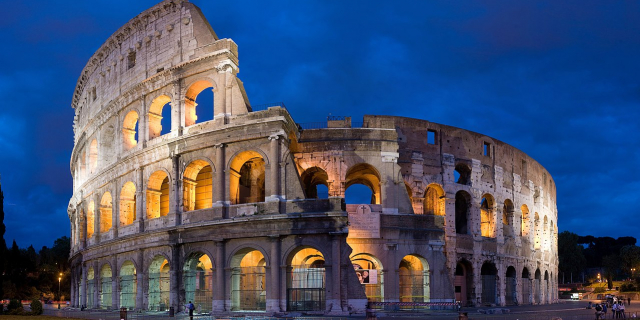Villa Adriana
( Hadrian's Villa )Hadrian's Villa (Italian: Villa Adriana; Latin: Villa Hadriana) is a UNESCO World Heritage Site comprising the ruins and archaeological remains of a large villa complex built around AD 120 by Roman Emperor Hadrian near Tivoli outside Rome.
It is the most imposing and complex Roman villa known. The complex contains over 30 monumental and scenic buildings arranged on a series of artificial esplanades at different heights and surrounded by gardens decorated with water basins and nymphaea (fountains). The whole covers an area of at least a square kilometre, an area larger than the city of Pompeii. In addition to the villa's impressive layout, many of the buildings are considered masterpieces of architecture, making use of striking curved shapes enabled by extensive use of concrete. They were ingenious for the complex symmetry of their ground plans and are considered unrivalled until the arrival of Baroque architecture in the 1600s initiate...Read more
Hadrian's Villa (Italian: Villa Adriana; Latin: Villa Hadriana) is a UNESCO World Heritage Site comprising the ruins and archaeological remains of a large villa complex built around AD 120 by Roman Emperor Hadrian near Tivoli outside Rome.
It is the most imposing and complex Roman villa known. The complex contains over 30 monumental and scenic buildings arranged on a series of artificial esplanades at different heights and surrounded by gardens decorated with water basins and nymphaea (fountains). The whole covers an area of at least a square kilometre, an area larger than the city of Pompeii. In addition to the villa's impressive layout, many of the buildings are considered masterpieces of architecture, making use of striking curved shapes enabled by extensive use of concrete. They were ingenious for the complex symmetry of their ground plans and are considered unrivalled until the arrival of Baroque architecture in the 1600s initiated by Borromini who used Hadrian's Villa for inspiration.
The site, much of which is still unexcavated, is owned by the Republic of Italy and has been managed since 2014 by the Polo Museale del Lazio.
The villa was constructed near Tibur (modern-day Tivoli) as a retreat from Rome for Emperor Hadrian during the second and third decades of the 2nd century AD. Hadrian is said to have disliked the palace on the Palatine Hill in Rome, leading to the construction of the retreat.[citation needed] It was traditional for the Roman emperor to have constructed a villa as a place to relax from everyday life. Previous emperors and Romans with wealth had also constructed villas (e.g. Villa of Trajan). Though emperors' villas were supposed to be a place of rest and leisure, there is some evidence of Hadrian conducting official duty from the villa in the form of an inscription of an official letter sent from the villa in the summer of 125 AD.[1]
The picturesque landscape around Tibur had made the area a popular choice for villas and rural retreats. It was reputed to have been popular with people from the Spanish peninsula who were residents in the city of Rome.[citation needed] This may have contributed to Hadrian's choice of the property: although born in Rome, his parents came from Spain and he may have become familiar with the area during his early life. There may have also been a connection through his wife Vibia Sabina (83–136/137), who was the niece of the Emperor Trajan. Sabina's family held large land holdings and it is speculated the Tibur property may have been one of them. A villa from the Republican era formed the basis for Hadrian's establishment.[citation needed]. Hadrian began construction on the villa early in his career as emperor, though brick stamp evidence shows us that construction of the villa was ongoing.[2]
During the later years of his reign, Hadrian governed the empire from the villa.[citation needed] He started using the villa as his official residence around AD 128. Therefore, a large court lived there permanently and large numbers of visitors and bureaucrats would have to have been entertained and housed temporarily on site.
After Hadrian, the villa was used occasionally by his various successors (busts of Antoninus Pius (138–161), Marcus Aurelius (161–180), Lucius Verus (161–169), Septimius Severus and Caracalla have been found on the premises).[3] Zenobia, the deposed queen of Palmyra, lived near the villa from 273 until her passing. The villa was restored by Diocletian during the final decades of the third century.[1]
During the decline of the Roman Empire in the 4th century, the villa gradually fell into disuse and was partially ruined as valuable statues and marble were taken away by Constantine the Great and his successors. The facility was used as a warehouse by both sides during the destructive Gothic War (535–554) between the Ostrogoths and Byzantines. Remains of lime kilns have been found, where marble from the complex was burned to extract lime for building material. Building material was also reused by the Christians to build basilicas and other buildings.[citation needed]
The first documented rediscovery of the villa was by Historian Biondo Flavio in the late 15th century who brought its attention to Pope Pius II whose writings on the villa in his Comeratti began to pique architectural interest in the villa.[3] In the 16th century, Cardinal Ippolito II d'Este had much of the remaining marble and statues in Hadrian's Villa removed to decorate his own Villa d'Este located nearby.[2][3] Since that period, excavations have sporadically turned up more fragments and sculptures, some of which have been kept in situ or housed on site in the display buildings.[citation needed]
There were no stratigraphical excavations on most of the site and much information was lost forever. Only from the end of the 19th century have its architecture and functionality begun to be studied scientifically.



























Add new comment